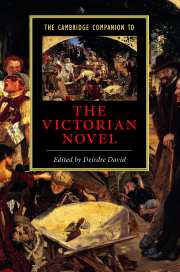Book contents
- Frontmatter
- Introduction
- 1 The Victorian novel and its readers
- 2 The business of Victorian publishing
- 3 The aesthetics of the Victorian novel: form, subjectivity, ideology
- 4 Industrial culture and the Victorian novel
- 5 Gender and the Victorian novel
- 6 Sexuality in the Victorian novel
- 7 Race and the Victorian novel
- 8 Detection in the Victorian novel
- 9 Sensation and the fantastic in the Victorian novel
- 10 Intellectual debate in the Victorian novel: religion, science, and the professional
- 11 Dickens, Melville, and a tale of two countries
- Guide to further reading
- Index
1 - The Victorian novel and its readers
Published online by Cambridge University Press: 28 May 2006
- Frontmatter
- Introduction
- 1 The Victorian novel and its readers
- 2 The business of Victorian publishing
- 3 The aesthetics of the Victorian novel: form, subjectivity, ideology
- 4 Industrial culture and the Victorian novel
- 5 Gender and the Victorian novel
- 6 Sexuality in the Victorian novel
- 7 Race and the Victorian novel
- 8 Detection in the Victorian novel
- 9 Sensation and the fantastic in the Victorian novel
- 10 Intellectual debate in the Victorian novel: religion, science, and the professional
- 11 Dickens, Melville, and a tale of two countries
- Guide to further reading
- Index
Summary
When the emancipated slave, William Wells Brown, visited England in 1850, he made a short visit to the “far-famed city of Oxford . . . one of the principal seats of learning in the world.” Here, he admired the architectural beauties of the university, and, when night fell, walked around the colleges which back onto Christ Church meadow:
I could here and there see the reflection of light from the window of some student, who was busy at his studies, or throwing away his time over some trashy novel, too many of which find their way into the trunks or carpet-bags of the young men on setting out for college. As I looked upon the walls of these buildings I thought, as the rough stone is taken from the quarry to the finisher, there to be made into an ornament, so was the young mind brought here to be cultivated and developed.
Brown’s focus of interest is salutary. Reading provoked a good deal of anxiety during the Victorian period. At the centre of this anxiety about what constituted suitable reading material and ways of reading lay concerns about class, and concerns about gender. In both cases, fiction was regarded as particularly suspect: likely to influence adversely, to stimulate inappropriate ambitions and desires, to corrupt. But in the case of Brown, a man who is painfully aware of the value of education, and of the advantages which privilege bestows, we see someone who is less troubled by the thought that this young man might be learning dangerous lessons from his novel, than someone who cares that he is frittering away his time, wasting those opportunities for learning from which others could gain so much. He seizes the chance to regret how “few of our own race can find a place within their walls,” and to emphasize the need, among black people, to turn their attention seriously to self-education.
- Type
- Chapter
- Information
- The Cambridge Companion to the Victorian Novel , pp. 17 - 36Publisher: Cambridge University PressPrint publication year: 2000
- 1
- Cited by



